Starting tomato seedlings in spring is easy to do and it can take up to 8 weeks for them to finally be able to sprout. But once the sprout, what if they stop growing? Why does that happen, and is there anything you can do about it?
The most common reasons tomato seedlings don’t grow are: too little or too much water, temperature that’s too hot (above 100 degrees F) or too cold (below 40 degrees F), or nutrient deficiency. The easiest remedies are: adequate water, fertilizer, and temperature between 70 – 85 degrees F.
Since there are several possible causes, it’s good to look at each one. And, once you identify the cause, there are several remedies that can be used. Let’s dive in & take a look at why tomato plants aren’t growing, and what you can do to fix the problem.
The most common causes for tomato seedlings not growing
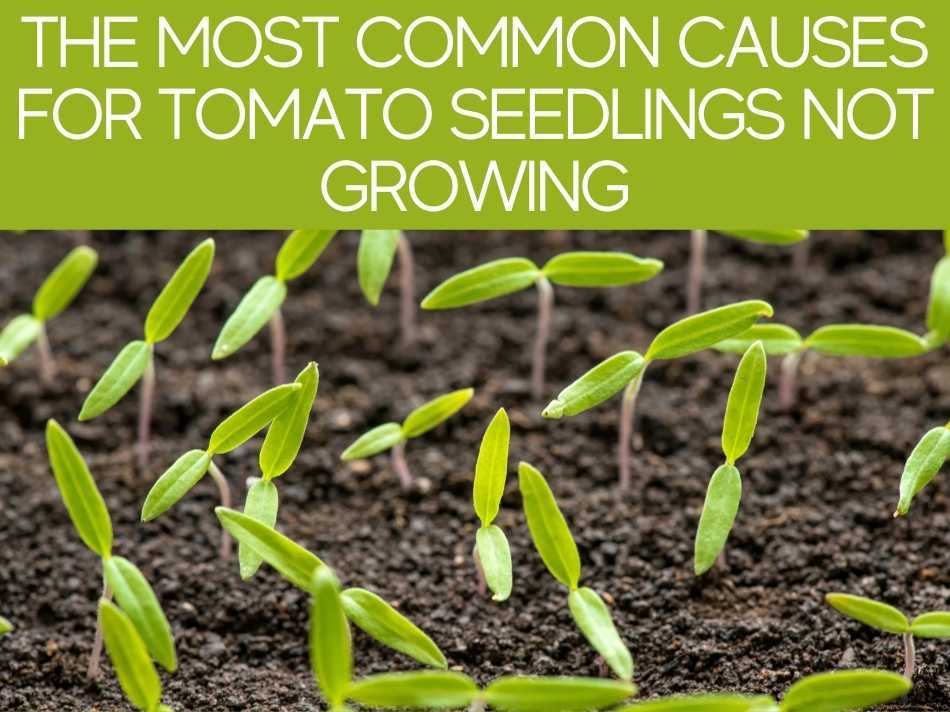
Without pointing out all the causes, it’s best to start with the easiest ones.
Temperature that’s too hot (above 100 degrees F) or too cold (below 40 degrees F)
The high temperatures in midsummer might be great for growing tomatoes and other warm season crops.
The problem is tomatoes need about 70 degrees of heat for them to develop their flowering cycle, and from there on growth is slow until they become established & begin flowering again.
But, if it gets too hot (above 100 degrees F), or if it’s too cold (below 40 degrees F), tomato seedlings will stop growing.
Some gardeners are astonished to find out that temperatures under 40 degrees F can be a problem.
You can check out our full answer for “Is 40 degrees at night too cold for tomatoes?”
But, if you don’t have a greenhouse, or live in a cold climate, low temperatures can be especially problematic.
Even without the frost, the cold can shut down growth.
Specifically, this university found that temperatures below 55 degrees prevents tomatoes from setting fruit.
Too little or too much water
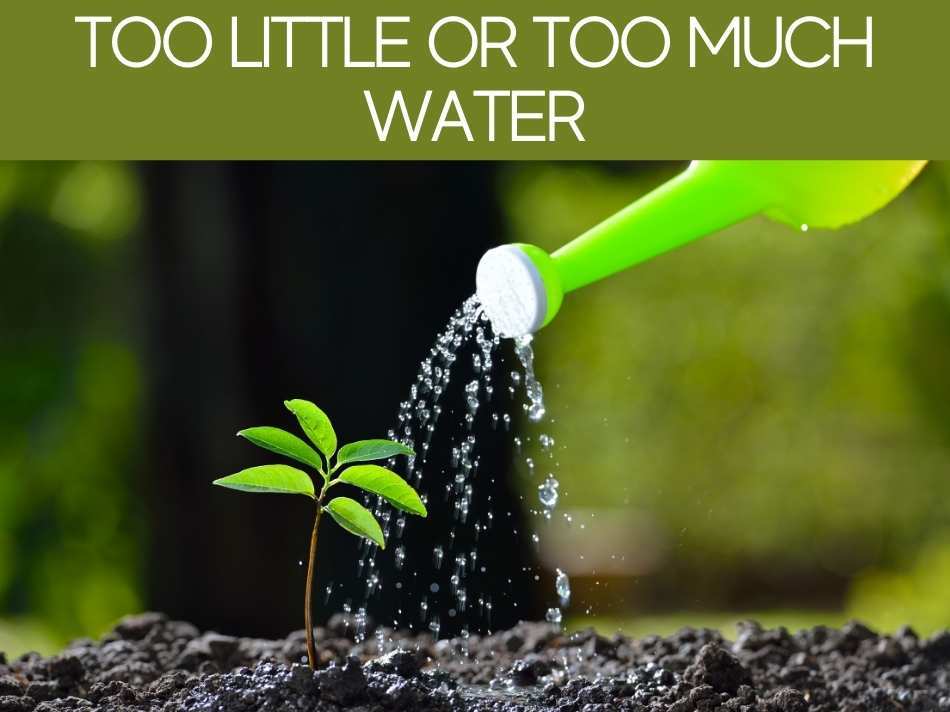
Adding water will help your tomato seed sprout but once it has sprouted, it needs to be watered on a regular basis to ensure that the plant reaches its full potential.
Sometimes some seeds in your packet can dry out or have moisture deficiencies which causes seedlings to stop growing.
Seedlings need water, but they don’t like to sit in water.
If your soil mix is very sandy, you may need to be sure that excess water can drain away, and be sure that the soil isn’t soggy for very long.
If you’re watering from below, try watering from above if possible instead.
Nutrient deficiencies
For tomato seedlings, the most common nutrient deficiencies are: phosphorus and potassium.
If your seedlings are turning yellow, check out our complete article on the causes & fixes.
If your soil mix does not have enough phosphorus, then the plant will slow down and put less energy into roots.
Since the roots don’t get much nutrients, they will be forced to use a lot of water which can be too much for them to handle.
Seeds need to germinate but if there is not enough nitrogen, the plants will have lower yields because they are using a lot of energy for growing and flowering.
To fix nutrient deficiencies for tomato seedlings, you can buy some of the following: bone meal, phosphorus, potassium, and nitrogen.
And, although these are the most commonly needed nutrient deficiencies in tomato seedlings, others are magnesium & manganese.
If you’re having problems with your tomato seedlings not growing well or stunted growth, then you should take a look at your soil mix and see if there is enough of all the required major & minor nutrients.
You can also use compost for added nutrients.
Why are my tomato seedlings growing slowly?
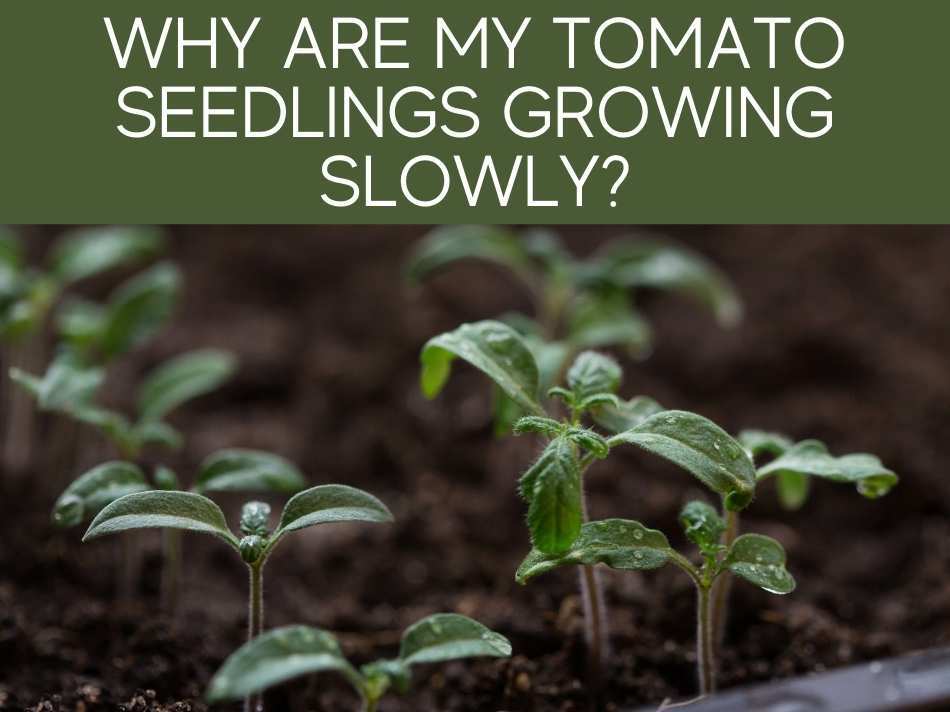
As tomatoes are an important plant in our gardens, it is always good to know the reasons why your tomato plants aren’t growing fast enough or well enough.
If you take a look at the above causes, then you’ll get a better idea of what’s going wrong.
For tomato seedlings growing very slowly, there are a few common causes.
If you do nothing, the tomato seedlings will eventually become established and begin their development cycle again.
But that still won’t help your tomato plants grow as fast as they need to grow. If you want them to grow faster, then there are ways you can do it.
For example, supplying the right amount of water is important. Just like in humans, if you don’t hydrate your plant well enough, then your plants will not develop properly.
Tomato seedling root systems are small and often fragile.
They need only a measured amount of water to get some moisture into the roots so they can start growing well again.
When you water your tomato seedlings or transplants deeply (often), what you’re doing is washing away the nutrients that are inside the soil since they cannot be absorbed any more.
So, to prevent that problem, you need to keep the soil mix damp but never soggy.
If you’re starting your seedlings in a pot, then it’s actually better to let them out of the pot once they have started growing quickly.
That way, they can develop a stronger root system and they’ll be able to get more of the nutrients that are in your soil mix.
You should also use mulch for better tomato plant growth. Mulch will help retain moisture, prevent weed problems, and keep down soil temperatures.
In addition, mulch will stop the top layer of the soil from drying out too quickly which can kill young plants.
Tomato plants growing very slowly
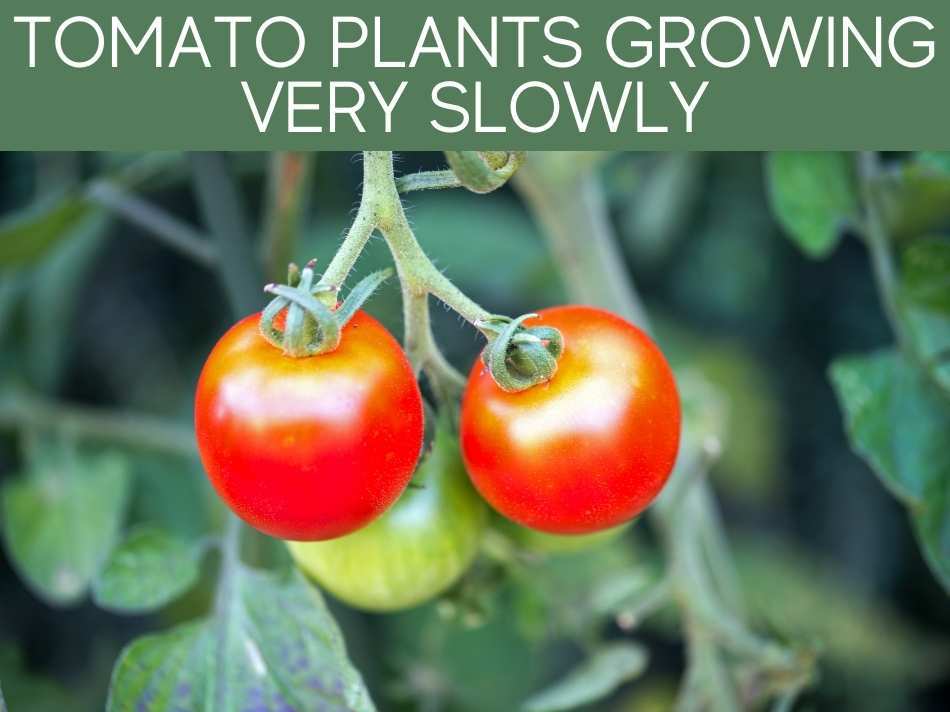
Once tomatoes are past the seedling stage, they will begin to put on growth at a much faster rate.
By the time your plants are about knee high, they will be putting on growth at a rate of about an inch per day.
However, if you run into problems, you might be asking yourself: “Why are my tomato plants not growing?“
You probably want to check out our full tips & tricks for how to grow more tomatoes.
When your tomato plants begin to grow very slowly, it may be because of the following reasons:
Over or under watering
Over watering is one of the main reasons why tomato plants grow so slowly.
That’s because when you over water them, you wash away all the nutrients in their soil mix.
Tomato plants need plenty of water, but they also do not like too much water.
If your tomato plants have run out of water, then you may see your leaves wilting.
When this happens, you will want to give your plants more water.
However, if you overwater your tomato plant, then the roots can rot and this will eventually cause the entire plant to die.
Deficient nutrient levels
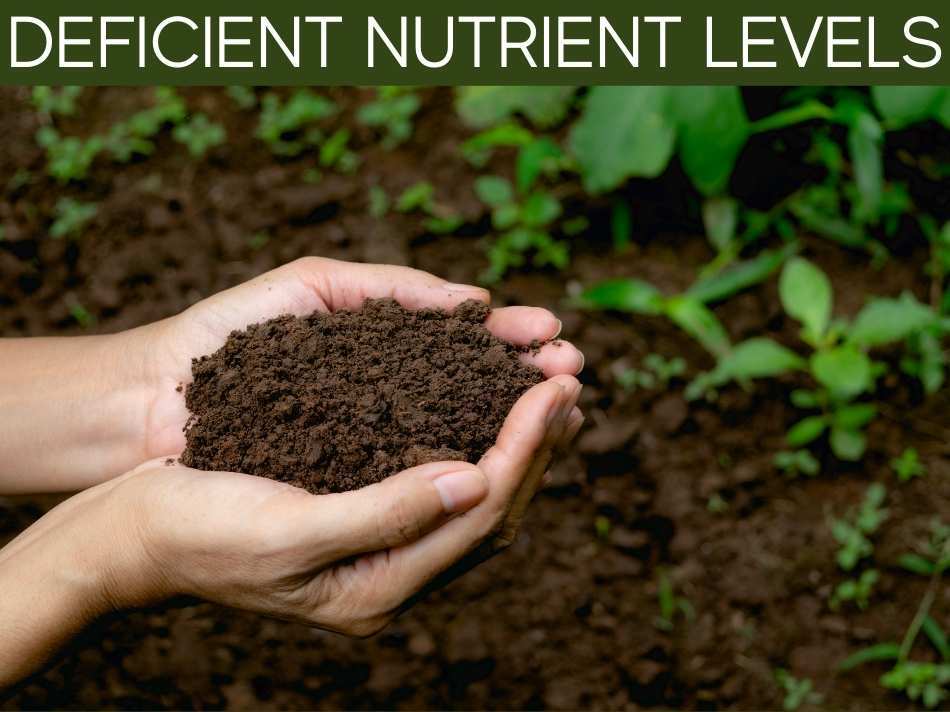
Sometimes, plants will not grow despite having all the correct nutrients in their soil mix.
If you let your tomato seedlings get too big for their space–in other words, rootbound–they can stop growing, flowering, or producing fruit.
In particular, nitrogen is very important for fast tomato plant growth. With enough nitrogen, your plants can become lush and green (good).
Too little nitrogen results in slow or stunted growth (bad).
Too much heat
If your tomato plant is growing in a spot that has direct sunlight, then it might be getting too much heat.
Tomatoes love full sun but they also need to be protected from too much direct sunlight or they may burn up and die.
If this happens to your tomato plants, you should move them to a shadier spot.
Specifically, with temperatures over 90 degrees Fahrenheit, tomato plants will start to grow very slowly.
You can tell if the temperature is too hot for your tomatoes by looking at the color of their leaves.
If they are looking pale green or yellow, then it’s time to move your plants to a cooler spot.
Also, with temperatures over 90 degrees Fahrenheit, tomato flowers may fall off or fail to set fruit.
Usually, you can fix the problem of too high temperature by putting up a shade cloth to provide your tomato plants some protection from the sun.
Too much fertilizer
If you over fertilize your tomato plants, they get “leggy” and grow tall with very weak stems, making them more susceptible to falling over in the wind.
Tomato plants can be fertilized by two different methods: in-ground and container.
Your choice of fertilizer method depends on whether or not you plan to transplant your tomato seedlings outdoors or keep them indoors for the whole season.
Not enough sun
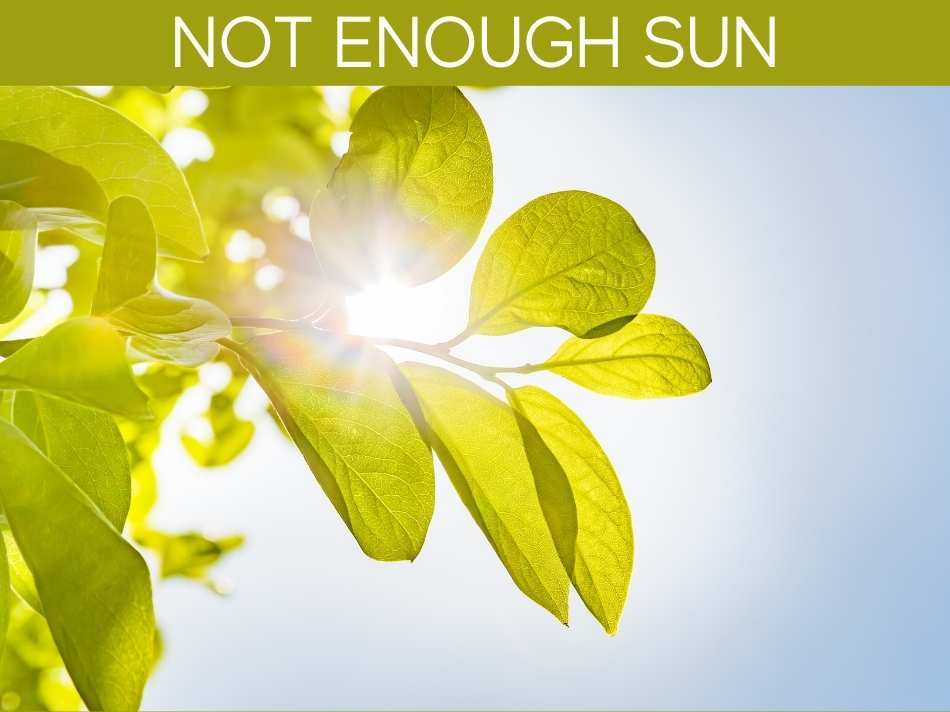
If your tomato plants are growing in a spot where they get no sunlight at all, then they will not grow well.
So, if you’re growing your tomatoes indoors, then it’s important to keep them near a sunny window.
If you’re growing them outdoors, then make sure they get plenty of sunlight every day.
Ideally, tomato plants require 6-8 hours of full sun every day.
Stunted tomato plants
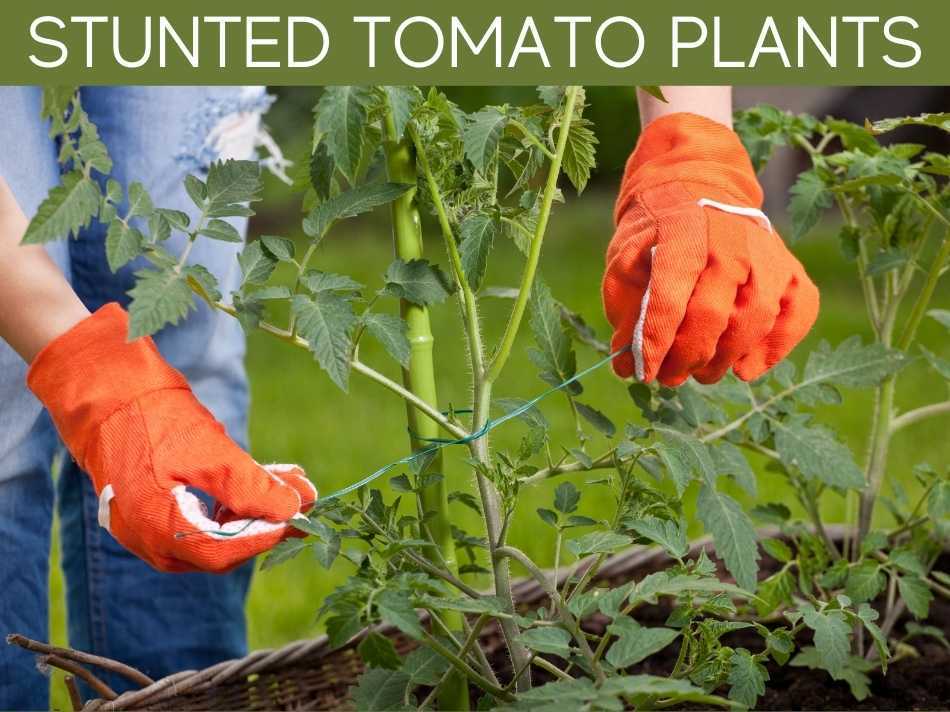
Stunted tomato plants means that they:
- develop fewer leaves than normal,
- aren’t growing taller,
- produce fewer flowers,
- flowers don’t turn into fruit, or
- fruit doesn’t ripen.
Stunted tomato plants can be caused by too little or too much of any of the following:
- water,
- sunlight,
- air circulation, and
- temperature.
The easiest way to fix stunted tomato plants is to change the situation that is causing it in the first place.
Stunted tomato plants are caused by poor overall plant health.
Some of the most common causes in this category include:
Rootbound
Sometimes sandy soils will block the flow of nutrients up to the leaves of your tomato plants. This can also happen in clay soils.
Rootbound problems can be prevented by:
- adding more organic matter to your soil mix,
- rotating plants in their pots, and
- using a potting mix with extra grit or sand or both.
Fertilizer deficiencies
If you’re using the wrong type of fertilizer for your tomatoes, then it’s possible that they will fail to grow properly.
Either too much nitrogen, too little phosphorus, or a combination of both is probably what’s happening with your tomatoes.
If you see this happening, then you should use a good-quality organic fertilizer (like bone meal or blood meal) to help restore your plants’ nutrient levels.
Sunlight
One of the greatest enemies of both tomato plants and tomatoes themselves is sunlight.
If your garden receives too much direct sunlight, then you’ll find that tomatoes aren’t as lush or as productive as they should be.
Depending on when in their growth cycle your tomato plants are getting more light, you may need to move them under a shade cloth or into a greenhouse.
If your tomato plants are getting too much sun, then they can burn up: leafs dry & turn crispy, and the plant can die.
Temperature
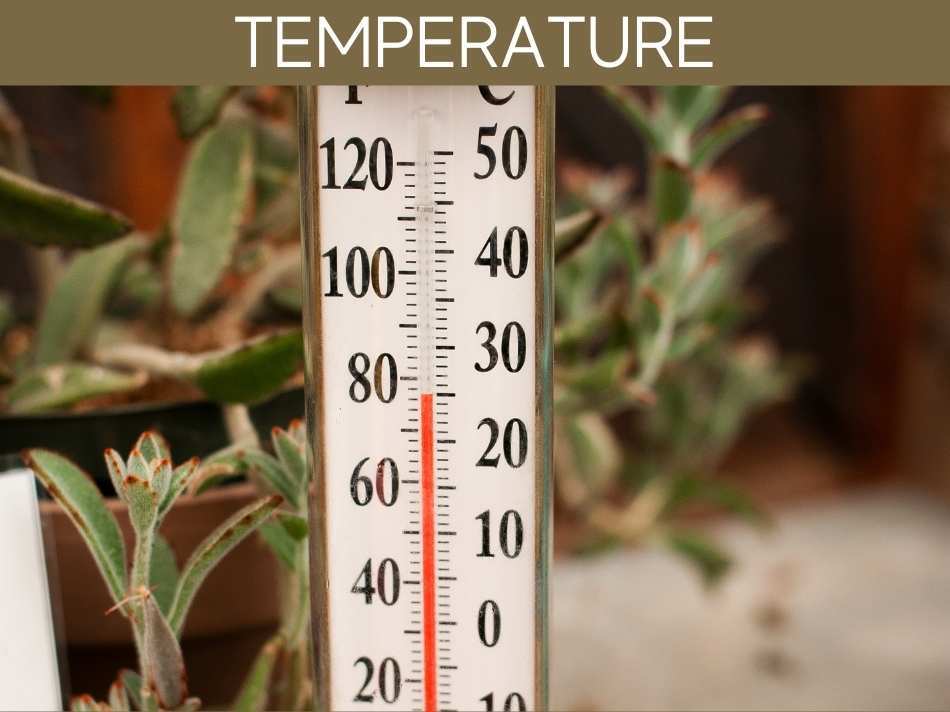
Tomatoes prefer temperature between 70 – 85 degrees Fahrenheit.
If your tomato plants are getting too hot or too cold, then they won’t grow properly and/or they’ll be less productive.
For example, if you’re growing your tomatoes in a spot where the temperature is too high, then you’ll find that your tomato leaves will start to burn and turn crisp.
If it’s bad enough to damage the leaves & stems, then they may die.
With cold temperatures–below 50 degrees Fahrenheit- your tomato plants may start to grow slower and may produce fewer flowers.
Watering too often or not enough
If you’re watering your tomato plants too frequently or for too long–for example, below the soil line– then you can cause the roots to rot which will eventually cause the entire plant to die.
This is why it’s important to keep the soil moist but not soggy.
Why are my tomato plants not growing tall?
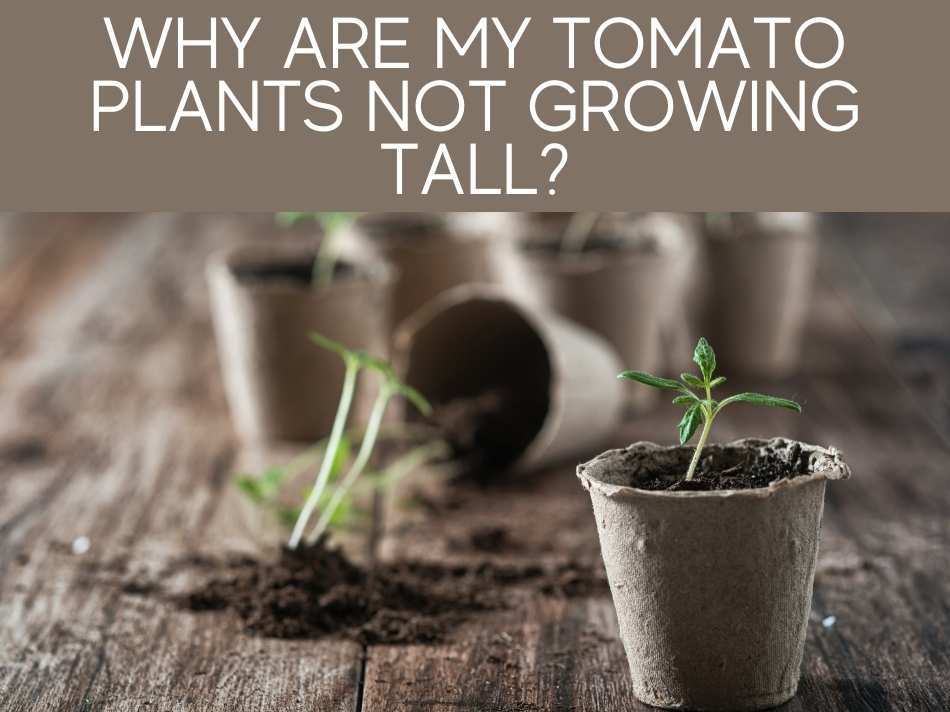
If your tomato plants are not growing tall, the most common reasons are:
Too little water
If your tomato plants are not getting enough water, they will be unable to develop the proper structure to support their fruit and flowers.
If your soil mix is dry, then you should water the plants and let them soak up as much as they can.
Nutrient deficiencies
If your tomato plants are not getting the right amount of nutrients, then they won’t grow as tall as they could.
Some nutrients that may be deficient include: phosphorus, potassium, nitrogen, calcium, and magnesium.
University studies have found that the most common reason for tomato plants not growing tall is phosphorus deficiencies.
To fix this problem, simply add a good-quality organic fertilizer, like bone meal or blood meal, to your tomato plants’ soil mix.
Too much heat or too much cold
Tomatoes like it between 70 – 85 degrees Fahrenheit (21 – 29 degrees Celsius).
If your tomato plants are getting either too hot or too cold, then they will grow slowly and/or produce fewer flowers.
Tomato and pepper plants not growing
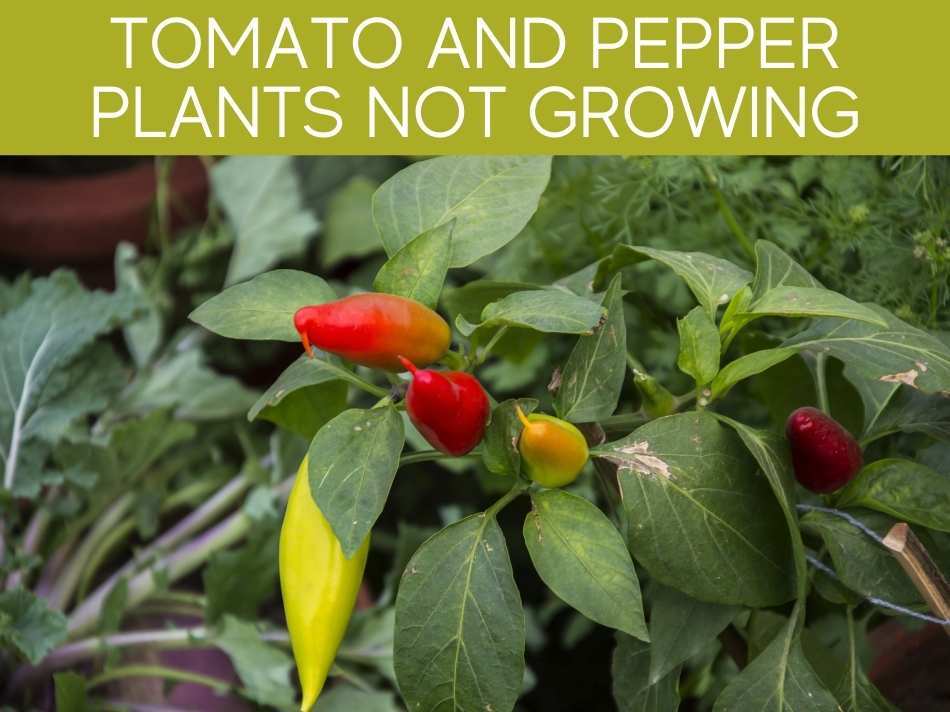
Tomatoes and peppers often prefer similar conditions in the garden, but these plants may have some specific requirements.
When a pepper plant is not growing too well, there are quite a few things that can be causing its lack of success.
For example, if your pepper plant is not getting enough water, then it will have to use up its limited reserves of water.
This will slightly reduce the strength of the plant’s roots, making it more susceptible to problems.
If your pepper plant is not getting enough light, then it may develop a weak root system and/or smaller leaves.
If you are unsure if your plants need more nutrients or more water, then you can try improving their soil mix.
For tomatoes, it’s possible that you may be missing one or more of these things:
Correct soil preparation and planting depth
Tomatoes prefer to have well-drained soil depths.
For planting depth, the standard recommendation for tomato plants is to plant them so that the soil is up to their first set of true leaves.
This is because tomato can grow roots along their stems.
So, planting tomatoes a little deeper is recommended by university studies and commercial growers.
Deeper planting means that the tomato plants will be able to grow larger roots and absorb more nutrients.
Watering and watering frequency
It’s also important to water your tomatoes at the right time and in the right way.
You’ll need to use about 1 inch of water weekly for good tomato growth. Watering deeply and less frequently is always better than shallow watering more frequently.
Cold soil temperature at night
Tomatoes that are grown in cooler climates often require a slightly longer growing season in order to produce a full crop of fruit.
Not enough light
If the lights in your garden aren’t strong enough, then your tomato and pepper plants will not grow. The best way to fix this is to move them to a spot with more sunlight.
The most common and likely reason for growth problems with an otherwise healthy plant is watering—either over or under-watering. Look out for early signs of under-watering, which include yellow leaves, dry soil, and wilting.
Usually, a tomato plant’s sluggish development is due to soil or water problems. As a simple solution, ensure that your plants are neither over- nor under-watered. Ensure that your soil is well-drained and slightly acidic.
If you expose your tomato plants to frost, it can stunt or delay growth.
Plants exposed to too much water can end up with stunted growth. Tomatoes thrive in well-drained soil, which should be more sandy than clay.
Do not over-water the plant and pay attention to the pH of your potting mix.
This plays a big role in how fast your tomato plant grows.
Ever wondered how to grow more tomatoes? This article contains everything you need to know.
Tomato Plants Not Growing After Transplant
If you’ve moved your plants into the ground within the last 30 days and haven’t seen much growth, it’s possible that they’ve experienced a transplant shock.
Many people believe transplant shock is worse or more severe than it is.
Depending on the plant and the conditions into which they transplanted it, it is often just a short-term stressful event for the plant in which it fails to thrive for one to four weeks.
To assist the plant, ensure that it has the conditions it needs to thrive (whether that be dry or moist soil, full or part sun, fertilizer, etc). Most plants will recover, and you will know which plants have recovered from transplant shock by their sudden fresh growth.
One of the most common things tomato plant growers struggle with is transplants taking too long to grow.
Knowing when to transplant your tomato plant is key, and the best time to do it is when the plant reaches three times the height of its container.
Some tomato plants look like they are struggling, but there are lots of growth under the soil level.
To support the obviously larger top growth, tomato plants must produce roots in the newly available soil.
The soil conceals the growth, as the roots are not visible.
It is incorrect to transplant small plants into excessively large pots.
Use a fertilizer that contains less nitrogen than phosphorus and potassium.
Tomatoes should not be over-watered. They prefer to dry out a little.
To help them learn a new direction, fluff the roots and cut a few.
This can improve root growth as well.
Ever wondered how many tomatoes one plant can produce? Read this article and find out.
Tomato Plants Not Growing Fruit
If your tomato plants have beautiful foliage but no tomatoes, improper lighting or hydration may be to blame.
Plants need six to eight hours of full sun to bloom and generate fruit.
Without this, you’d have lanky or leggy foliage and flowers, with very few tomatoes. Sunlight powers fruit production in plants.
If your tomato plants lack light, reposition them.
Tomatoes need lots of water, while insufficient water stunts fruit growth.
If the tomato plant doesn’t get enough water, it may only produce a few blossoms.
Temperature and inadequate pollination cause this.
To produce fruit, tomato plants need temperatures of 65-70 F/18-21 C during the day and 55 F/13 C at night. Above 85 degrees Fahrenheit/29 degrees Celsius, they will not bloom or bear fruit.
If you have a lot of blossoms but no tomatoes, it may be too cold, damp, or dry, causing blossom drop, which hinders plant fruit production.
Cold, windy, or wet weather reduces bee activity, which aids pollination and fruit set.
Once the weather returns to normal, you can hand-pollinate them.
Improper tomato spacing reduces fruit set and can hamper pollination in hotter climates.
Pollen becomes infertile during hot spells with daytime temperatures exceeding 30oC (86oF) and nocturnal temperatures exceeding 24oC (75oF).
Tomatoes like heat, but not too much of it, and the absence of humidity complicates matters.
Maintain healthy and well-watered plants so that they can resume production when temperatures fall.
Different tomato varieties thrive in various climates. Grow a heat-tolerant cultivar in tropical climates.
High humidity can clog pollen, preventing it from falling, whereas in dry climates, flowers may become parched, causing pollen to roll off.
Watering regularly may help to improve plant conditions by increasing humidity.
See how to grow tomatoes over winter.
Tomatoes Plants Staying Small
Plants that are stressed produce tiny tomatoes.
Dryness, heat, insects, or disease stresses tomato plants, and they stop producing flowers and fruits.
Instead of concentrating on the aerial parts of the plant, plants will concentrate on the roots, which will survive.
Plants that are stressed may stop producing flowers and fruit.
The main reasons tomato fruit does not grow are drought or improper care.
Never allow tomatoes to wilt.
To avoid wilting, leaf drops, and tiny tomatoes, keep the soil moist. Self-watering pots provide sufficient soil moisture for tomato growth.
Tomato plants that are healthy will grow under favorable conditions, but if a factor isn’t favorable, their growth will decrease or cease. It may afflict tomato plants that cease to grow because of a disease or insect infestation, or they may just require trimming or a nutrition boost.
Pests and illnesses can cause difficulties even if you prune and feed your tomato plant.
A plant must use its energy to fight off a pest or illness, although the plant may be fine if your tomato plant is healthy and producing fruit.
Your plant might be dormant, although determined plants will reach a specific height and produce a specific number of fruits, which is a genetic trait that cannot be altered.
Until the first freeze, indeterminate plants produce an infinite number of fruits while determinate plants produce a terminal flower cluster when they reach their maximum height.
The weather hampers plant growth at temperatures that are too cold or too hot.
Temperatures above 90 degrees Fahrenheit prevent tomatoes from fruiting, while temperatures above 75 degrees Fahrenheit at night cause problems.
Growth slows below 50°F. In extreme temperatures, plants rely on survival rather than development.
Summary thoughts
Even experienced gardeners can encounter issues with fruits and vegetables that they have grown for years.
While blight diseases and insects are common tomato problems that most of us have encountered at some point, some less common issues arise.
Giving a struggling tomato plant a supercharged nutrient boost is the quickest way to bring it back to life.
One that can be used several times over two to three weeks to help tomato plants revive and thrive.
Young plants have difficulty absorbing nutrients from the soil when they have too much or too little rain, or cold or hot weather when they are young and vulnerable.
However, by supplementing your plants with a potent dose of nutrients, you can almost always jump-start their growth in record time.
You’ll be laying the groundwork for an incredible mid-and late-season tomato harvest.
It’s amazing how your plants can turn the corner in just a few weeks.
With a little TLC, you can turn your struggling tomato plants around.
Conclusion
If your tomato seedlings or tomato plants are growing slowly or not at all, then you should monitor their progress daily.
For plants are stunted, rootbound or have a deficiency of any of the required nutrients, then you’ll want to use a good-quality organic fertilizer to restore them.
If your tomato plants are getting too much heat or too much cold, then move them away from those conditions.
When tomato plants are watered too often or for too long–for example, below the soil surface–then they may develop root rot which will eventually kill them.
Tomato plants produce fruit all season long, but they prefer full sun and moderate temperatures (70 – 85 degrees F) for their best performance.
In addition, tomatoes sometimes need to be fertilized and watered regularly. If your tomato plants are not growing as you expect, then try out the tips above.
Happy gardening, and let’s look forward to growing more tomatoes!

